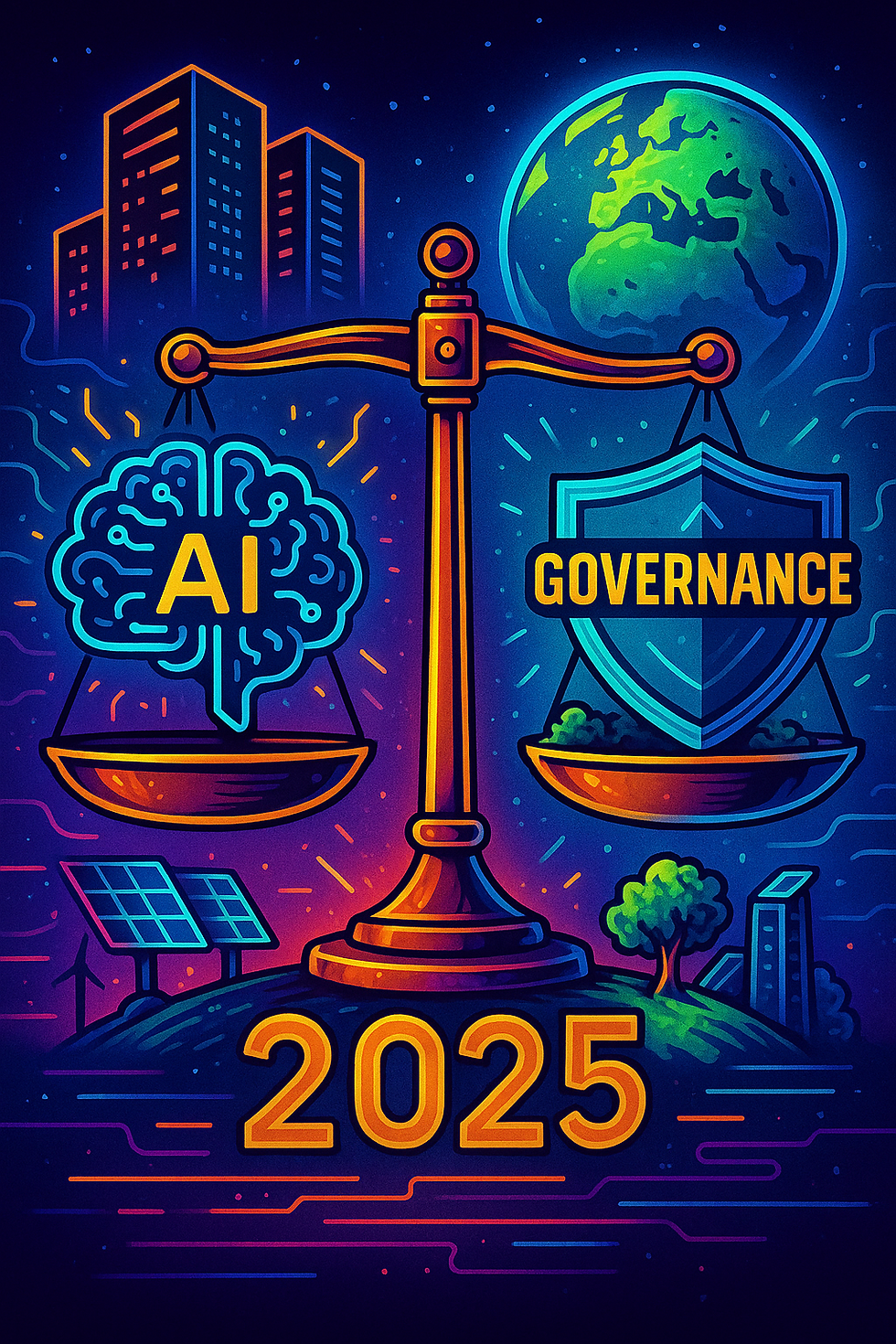AI Trends in 2025: A Deep Dive
- Mr_Solid.Liquid.Gas
- Jul 22
- 33 min read

Artificial intelligence has never moved faster—or felt more precarious—than it does in 2025. LLMs draw up code, predict proteins and negotiate supply chains, yet every breakthrough sharpens questions about energy, privacy, and control. The past year alone has seen self-directed AI agents slip from research demos into production workflows; open-weight models erode the once-formidable lead of closed giants; regulators abandon slow rule-making in favour of live sandboxes; and a global GPU shortage expose just how fragile the hardware bedrock of “infinite compute” really is.
This report distils ten trends and concerns that will shape the next wave of adoption. Each chapter pairs a concrete achievement—faster edge inference, synthetic data for privacy, small language models slashing cost-per-token—with its shadow side: hallucination risk, water-hungry data centres, and attack surfaces hidden deep in semiconductor supply chains. You will meet the new must-have role of AI Safety Team, track how governments use controlled test beds to prototype regulation, and watch a David-versus-Goliath cost battle between sleek SLMs and billion-parameter behemoths.
Our aim is practical foresight. For executives, we flag strategic pivots—dual-sourcing GPUs, budgeting energy caps, staffing red-team engineers—long before they hit the balance sheet. For practitioners, we offer benchmarks, design patterns and guard-rails ready to plug into today’s pipelines. And for policy shapers, we surface the hard trade-offs that no single stakeholder can solve alone.
Read on to discover where AI’s biggest opportunities—and its most urgent responsibilities—are colliding right now, and what your organisation can do to stay ahead without losing sight of the risks.
The Rise of AI Agents: Autonomy, Use-Cases, and Oversight

From static chatbots to self-directed digital co-workers
2025 has become the year when AI agents—software entities able to perceive a goal, plan a strategy, call external tools, and iterate until the job is done—moved from research labs to board-room slide decks. Analysts now group them into three broad “levels” of autonomy. Level 1 agents simply chain APIs in a script-like fashion; Level 2 agents reason over intermediate results and can adjust their plans; Level 3 agents pursue an objective over hours or days, handing off sub-tasks to specialized peers in a multi-agent system without fresh human prompts. Most production deployments remain at Levels 1-2, but pilot projects in finance, logistics, and biotech are already probing Level 3 capability. TechRadarAmazon Web Services
Architectures: from single-loop planners to swarming collectives
Under the hood, autonomous agents typically wrap a large language model (LLM) inside a loop: Think → Plan → Act → Observe → Learn. The loop may persist its memory in a vector database, spin up sandboxed micro-processes for tool calls, or spawn helper agents. Popular open-source frameworks such as AutoGen, PromptFlow, and PhiData provide templates for this orchestration, while commercial stacks like Devin or OpenAI’s forthcoming “Swarm” abstract away the plumbing for enterprise buyers. An agent “team” might include a planner that decomposes a problem, specialists that execute domain-specific API calls, and a critic that verifies outputs before returning a final answer. MediumCognition
Task automation across industries
Task automation is where the value crystalises. In software engineering, agents already draft pull-requests, trigger CI pipelines, and open Jira tickets when build logs fail, slashing cycle time by 35 % in early adopters. Customer-support desks route 60 % of tickets to a “resolver” agent that digs through knowledge bases and proposes refunds within SLA. Healthcare pilots pair an EHR-integrated diagnostic agent with a compliance agent that checks output against clinical-safety policies before anything reaches a physician. Banks deploy fraud-detection agents that cross-examine transaction streams in real time, while supply-chain operators rely on route-planning agents that adjust shipping when extreme weather hits. The common thread: letting multiple narrow agents collaborate tends to beat one monolithic model on both cost and latency. DataCampNature
Oversight: keeping autonomous agents on a short leash
With great autonomy comes fresh governance headaches. Boards are now told to treat agentic AI as “interns armed with root access”: helpful but prone to spectacular mistakes if unsupervised. Regulators on both sides of the Atlantic are experimenting with mandatory audit logs for tool calls, policy firewalls that stop agents from executing restricted actions, and “compute caps” that throttle runaway planning loops. Internally, leading companies embed AI Safety Teams responsible for red-teaming prompts, setting reward functions, and approving new tool integrations before an agent can execute them in production. A growing best practice is the Controller-Observer pattern: an oversight agent shadows every high-privilege action and can issue an emergency stop if confidence scores fall below a threshold. nacdonline.org7puentes.com
Challenges on the horizon
Even as fine-tuned guardrails reduce obvious failures, two open questions loom large. Value alignment: How do you encode nuanced, occasionally conflicting business objectives into a numeric reward without gaming? Liability: If an autonomous coding agent inserts GPL-licensed code into a proprietary repo, who is on the hook—vendor, operator, or model provider? Pending case law and the 2025 update to the EU AI Act will shape answers, but for now every deployment contract should spell out indemnity zones and kill-switch obligations.
Takeaways for leaders
Start small but design for orchestration—a clear API boundary between planner and tool calls will make it easier to scale to multi-agent systems later.
Instrument everything—embed trace logging and policy checks from day one to avoid expensive retrofits.
Invest in human-in-the-loop review—until models can reliably detect their own blind spots, oversight remains a people problem.
Treat agents as evolving products, not static code—continuous prompt, reward, and tool-chain updates are part of normal operations.
Autonomous agents will not replace your workforce overnight, but teams that master the art of pairing level-headed oversight with ambitious automation will out-iterate the competition.
Open-Weight vs Closed Models: Why the Gap Is Shrinking Fast

From a two-horse race to a crowded peloton
Only eighteen months ago, the performance leaderboard looked binary: premium closed-source AI (OpenAI’s GPT-4 family, Anthropic’s Claude 3, Google’s Gemini) at the front, and a distant pack of open models playing catch-up. Mid-2025 benchmarks tell a different story. Meta’s Llama 4 Behemoth now tops GPT-4.5 and Claude Sonnet on MMLU-STEM, HumanEval and GSM-Hard, while costing one-eighth as much to run on commodity H100 clusters. ai.meta.com Tech media outlets that once wrote off “hobbyist” LLMs now rank Llama 4, Qwen-2 MoE and Mistral-MoE 8×7B alongside the commercial incumbents in their Best LLM lists. TechRadar The upshot: the capability delta between closed and open models has collapsed from an estimated 18 months in 2023 to roughly 60 days in 2025.
Four drivers narrowing the chasm.
Data pluralism beats data hoarding
Closed vendors relied on vast proprietary text crawls plus expensive reinforcement pipelines. By contrast, today’s open-source AI projects harness collective curation: crowdsourced high-quality instruction sets (e.g., OpenOrca Medical), multilingual corpora donated by national libraries, and synthetic data produced by earlier-generation open models. The quantity is smaller, but the signal-to-noise ratio is higher, closing the accuracy gap on long-tail queries. IBM
Architecture innovation diffuses instantly
Once a research paper—Flash-Attention-3, Grouped-Query MoE Routing, or Dynamic Adapters—drops on arXiv, open communities integrate it within days. The permissive Apache-2/MIT ecosystems around frameworks like TinyGrad and vLLM mean innovative layers propagate laterally rather than vertically, compressing the iterative loop that once favoured closed labs.
Hardware democratization
The aftershocks of the 2024 GPU shortage pushed cloud providers to launch “community partitions” where researchers bid micro-grants of idle A100/H100 time. Low-rank-adaptation (LoRA) and quantization to 4-bit weights slashed fine-tuning costs by 90 %. Suddenly, you no longer needed a $10 million war chest to train a foundation model; a mid-sized university could contribute a 34 B-parameter checkpoint that performs respectably on reasoning tasks.
Evolving model licensing norms
Governments quietly accelerated the shift. In January 2025, the U.S. Commerce Department’s new Export Control rule classified unpublished closed-weight models above 10²⁶ FLOPs under ECCN 4E901, while explicitly exempting published open-weight models from license requirements. Federal Registerorrick.com The policy turned “open-weight” from a philosophical badge into a commercial advantage: you can ship a state-of-the-art Llama 4 checkpoint to Frankfurt or Jakarta with no paperwork, whereas a closed vendor must navigate months of compliance.
Strategic trade-offs executives should weigh.
Decision Axis | Open-Source AI | Closed-Source AI |
Total Cost of Ownership | 50-80 % cheaper at scale (hosting and inference margins accrue to you). | Pay-per-token or seat; costs drop only when vendor lowers prices. |
Customisation | Full control over weights; domain-specific adapters in hours. | Fine-tuning via APIs only; weight access prohibited. |
Liability & IP | Must audit datasets and licenses yourself; risk of GPL bleed. | Vendor indemnity packages transfer most IP risk. |
Support & SLAs | Community forums, emerging enterprise integrators. | 24×7 vendor support, uptime SLAs. |
Regulatory Exposure | Export freely but shoulder governance internally. | Easier compliance documentation, but subject to geo-blocking. |
Many enterprises now adopt a dual-stack: an open-weight model for internal analytics where data residency matters, plus a closed API for customer-facing chat where latency guarantees trump control. Senior ExecutiveMedium
Licensing: “open” is not a monolith
The phrase open-weight masks a spectrum from fully permissive (Apache-2) to source-available but usage-restricted (Llama Community v2, Mistral AI Non-Production). Legal teams must parse clauses on model redistribution, fine-tuning for commercial use, and downstream weight sharing. A recent Medium deep dive showed fewer than 40 % of self-described “open” checkpoints allow unfettered commercial fine-tuning. Medium Misreading these subtleties can torpedo a product launch when procurement demands proof of license compatibility.
Looking ahead: convergence or coexistence?
Industry observers debate whether truly “open” models will reach GPT-5-class multimodal reasoning before the closed titans leap again. But the trendline is unmistakable: every incremental gain on the closed side becomes an R&D roadmap for open collectives, and the replication lag keeps shortening. As one CTO quipped in the State of Foundation Model Training Report 2025, “the moat is now the workflow, not the model.” neptune.ai
For most organizations, the pragmatic stance is portfolio thinking:
Experiment with open checkpoints to derisk vendor lock-in and reclaim margin.
Benchmark routinely—capabilities shift quarterly, and yesterday’s 2-point accuracy gap may vanish after a community fine-tune.
Harmonise governance: a single policy covering dataset provenance, weight access controls, and audit logging should apply whether the model came from Hugging Face or a closed API.
Regulatory Sandboxes: How Governments Are Testing AI Rules Before Rolling Them Out

Why policy labs moved from fintech to GenAIA regulatory sandbox is a controlled test environment in which innovators can pilot innovative technologies under real-world conditions while the regulator watches every move, waives selected rules, and harvests data to refine future law. First popularised by the UK Financial Conduct Authority in 2015, the model has been transplanted to artificial intelligence because legislators know their first draft of an AI statute will be obsolete the moment it is printed. The sandbox flips the order of operations: experiment with oversight first, then write the binding rulebook. IAPP
The EU AI Act makes sandboxes mandatory.
The European Union has gone furthest. Article 57 of the EU AI Act obliges every Member State to stand up at least one AI regulatory sandbox—or join a multi-state version—by 2 August 2026. Participants that follow the sandbox’s guidance are exempt from administrative fines and can use the documentation they generate as proof of AI compliance when they later seek CE-marking for high-risk systems. Early pilots show big payoffs: companies that finished the UK’s fintech sandbox raised 6.6× more venture capital; Brussels believes a similar effect will boost SME AI uptake. Artificial Intelligence Act
The roll-out is patchy but accelerating. Spain’s Ministry of Economic Affairs ran the first national AI sandbox in 2022; Denmark, France and the Netherlands now have operational cohorts, while others let sectoral regulators—often data-protection authorities—take the lead. The EU is also funding the EUSAiR project and linking sandboxes to large-scale Testing & Experimentation Facilities (TEFs) so start-ups get both legal guidance and GPU time. Artificial Intelligence Act
The U.K.’s multi-regulator “hub” plus domain-specific sandboxes
Outside the single market, London has chosen a more flexible path. The Department for Science, Innovation & Technology (DSIT) backed a multi-regulator AI & Digital Hub that opened in 2024 as a one-year pilot. Firms can file a single query and receive joined-up advice from the CMA, ICO, Ofcom and the Financial Conduct Authority—reducing what ministers call the “compliance ping-pong” that throttles start-ups. Osborne Clarke
Agencies have launched vertical sandboxes too. The Medicines & Healthcare products Regulatory Agency (MHRA) unveiled AI Airlock in spring 2024 to explore how dynamically learning models fit into medical-device law. Its first cohort paired three hospitals with start-ups fine-tuning diagnostic LLMs on live imaging streams under heightened supervision. Lessons learned will feed into the UK’s forthcoming statutory duty of candour for adaptive AI. GOV.UK
Singapore turns the sandbox into an assurance market.
Singapore’s Infocomm Media Development Authority (IMDA) and the non-profit AI Verify Foundation ran a three-month “Global AI Assurance Pilot” in early 2025, matching 17 GenAI deployers with 16 specialist red-team vendors. The exercise matured into a standing Global AI Assurance Sandbox on 7 July 2025, aimed at cutting evaluation costs and seeding a private market for trustworthy-AI testing services. Participants receive technical guidance, introductions to approved testers and limited grants, but no formal relief from statutory duties—reflecting the city-state’s preference for quasi-voluntary governance over hard law. AI Verify Foundation
A patchwork in the United States
With no federal AI statute, action is bubbling up from states and agencies. Utah’s 2025 Artificial Intelligence Policy Act created “The Learning Lab,” the first state-run AI sandbox that offers time-bound regulatory mitigation in exchange for sharing data with academics. Texas, Connecticut, and Oklahoma have similar bills in committee, while the FDA is considering a sandbox for AI-enabled clinical trials. IAPP The National Institute of Standards and Technology (NIST) has signalled that its forthcoming AI Safety Institute will provide a “model evaluation sandbox” aligned with the AI Risk Management Framework, though details remain sparse. nvlpubs.nist.gov
What do policymakers hope to learn?
Risk calibration: Sandboxes collect empirical evidence on where AI regulation bites hardest and where it can safely be relaxed for low-risk use cases.
Tooling gaps: Regulators can evaluate audit logs, watermarking or bias metrics in situ before mandating them sector-wide.
Interoperability stress-tests: Multinational firms participate in several sandboxes at once, exposing conflicting requirements early enough to fix them.
Talent pipeline: Embedding civil-service lawyers and data scientists alongside start-ups upskills both sides and shortens future approval cycles.
Early impact numbers
In the EU’s TEF-health stream, sandbox participation shaved 40 % off average time-to-market for diagnostic AI. Artificial Intelligence Act
The U.K.’s AI & Digital Hub logged 320 enquiries in its first six months; 58 % came from companies with <50 staff, confirming that lighter-touch facilitation lowers barriers for SMEs. Osborne Clarke
Singapore reports that deployers cut evaluation costs by 30 % compared with hiring private red-teamers individually. AI Verify Foundation
Limitations & open questions
Scalability: Human-intensive supervision does not scale easily; authorities warn that demand already outstrips expert capacity in sandbox units.
Regulatory capture risk: Start-ups inside the tent may shape forthcoming rules to their advantage unless transparency and public-interest metrics are baked in.
Cross-border portability: Compliance evidence from one jurisdiction may not map cleanly onto another’s legal definitions—especially around data-protection law.
Liability fog: Even with temporary relief, providers remain liable for third-party harm; insurers are still pricing this novel risk class.
Action points for AI builders
Apply early—cohort spaces are limited and oversubscribed within days.
Clarify your experimentation goal: Regulators favour pilots that teach them something new—e.g., measuring explainability in multimodal models, not generic chatbots.
Prepare disclosure artefacts: model cards, training-data lineage and risk assessments accelerate acceptance and become reusable compliance collateral.
Budget post-sandbox work: Graduation is not automatic approval; you must still meet full AI compliance once the temporary waiver expires.
Regulatory sandboxes are morphing from curiosity to cornerstone of AI governance. Firms that treat them as cheap regulatory arbitrage will be disappointed; those that view them as a preview of tomorrow’s rules gain a decisive head-start in shaping—and meeting—the standards that will define trustworthy AI.
Water & Energy Footprints of LLMs: Can Green Compute Keep Up?

The AI sustainability conversation has shifted from abstract carbon accounting to a hard look at two finite resources every large-language-model (LLM) consumes in bulk: electricity and water. Training and running today’s frontier models already rival midsize nations in power draw, while cooling their GPU racks can strain local aquifers. As 2025 deployments mushroom—from hospital copilots to billion-user chatbots—the question is no longer whether AI workloads have a material energy footprint and water usage problem, but whether engineering, policy and market forces can rein it in before the next generation of models arrives.
1. Sizing the energy bill
Best public estimates put the one-off training run of GPT-4 at ≈ 52–62 million kWh, translating to 12–15 kilotonnes of CO₂-equivalent—roughly the annual emissions of 1,500 average U.S. homes Medium. Inference dwarfs that: OpenAI now pegs an “average” ChatGPT query at 0.3 Wh, an order of magnitude lower than 2023 headlines but still five-to-ten times a Google search Epoch AI. Multiply by ChatGPT’s current traffic (~8 billion prompts/month) and you arrive at ~29 GWh per year—equal to powering Iceland’s entire parliament for a decade.
Macro trends look steeper. The International Energy Agency warns global AI electricity demand could rise 10× between 2023 and 2026 as enterprises embed LLMs into everything from ERPs to edge cameras Business Insider. Analysts at WSJ note data centres already account for ~2 % of world power, and AI could double that without aggressive efficiency gains The Wall Street Journal.
2. The hidden water tab
Electricity is only half the ledger. Generative AI models sip, spray and evaporate staggering volumes of water to keep servers within thermal limits. A recent Bloomberg data dive found data centres already gulp ≈ 560 billion litres annually, on track to pass 1.2 trillion litres by 2030 if unchecked Bloomberg. Google alone disclosed using 22.7 billion litres (6 billion gallons) in 2024, an 8 % jump driven mainly by AI workloads Anadolu Ajansı. One Iowa campus drank nearly 1 billion gallons in a single year—more than its host city’s households combined Visual Capitalist.
At the micro scale, every 100-word GPT-4 answer can evaporate ~519 mL of water once indirect cooling is included, reminding users that seemingly “weightless” tokens carry a wet footprint too Business Energy UK.
3. Why water matters more than watts
Electricity can be shipped over high-voltage lines; water usually comes from the nearest watershed. When hyperscale campuses cluster in semi-arid regions of the U.S. Southwest, each GPU upgrade tightens competition between servers, farms, and households. Researchers estimate U.S. data centres already withdraw 449 million gallons per day—nearly 700 Olympic pools—before counting the next wave of AI accelerators EESI. Rising LLM carbon cost remains a global issue, but water scarcity hits local politics first, forcing moratoriums on new builds in parts of Arizona and the Netherlands.
4. Can green compute catch up?
Algorithmic thrift. Studies show “reasoning-heavy” models can emit 50× more CO₂ than concise peers while yielding marginal accuracy gains ScienceDaily. Serving a lightweight 7-B parameter assistant for boiler-plate queries and reserving giant MoEs for edge cases slashes both energy and water burn. Token-budgeting, context caching and speculative decoding further cut per-response joules.
Specialised silicon. Nvidia’s Blackwell GPUs claim 40 % better FLOPS-per-Watt, but the real frontier is low-precision edge AI ASICs that can inference small models at <2 W, avoiding round-trip traffic to thirsty hyperscale sites altogether.
Cooling innovation. Microsoft’s latest cradle-to-grave analysis finds liquid and immersion cooling shrink greenhouse emissions 15–21 %, energy use up to 20 % and water draw 31–52 % versus legacy air systems DataCenterDynamics. Schneider Electric and Nvidia are rolling out reference “AI-ready” blueprints that combine direct-to-chip cold plates with heat-recycling loops, promising 20 % cooling-energy savings on racks pulling 130 kW Business Insider. Industry trackers say liquid solutions attracted more investment in H1 2025 than in the previous five years combined datacenterfrontier.com.
Cleaner electrons. On the supply side, Google just inked a $3 billion hydro-power deal covering up to 3 GW of 24×7 carbon-free capacity for its U.S. data centres, allowing future AI clusters to grow without proportional emissions TechRadar. Wind-coupled battery farms in Texas and Spain are following suit, while some clouds now time-shift non-urgent LLM training to hours when grids are flush with renewables.
Mandatory disclosure. Yet green compute cannot be managed if it remains invisible: a May 2025 survey found 84 % of deployed LLMs publish no energy data at all WIRED. Governments are debating WUE- and PUE-style labels for models, mirroring nutrition stickers on food. If adopted, “carbon cost per million tokens” could become as routine a metric as top-1 accuracy.
5. Action checklist for AI teams
Priority | What to Do | Payoff |
Measure | Instrument power metres & water flow at node level. | Converts sustainability from guesswork to KPI. |
Model-size tiering | Route simple prompts to small models; escalate only when needed. | Cuts inference energy up to 90 %. |
Cooling retrofits | Evaluate cold-plate or immersion pilots; leverage vendor financing. | 15-20 % energy & 30 % water savings. |
Green PPAs | Contract 24×7 carbon-free energy or grid-matching services. | De-risks emission compliance, stabilises costs. |
Disclose | Publish lifecycle LCA with every major checkpoint release. | Builds trust with regulators & eco-conscious users. |
6. Bottom line
The race between ever-larger LLMs and the planet’s finite resources is tightening but not predetermined. Aggressive efficiency hacks, next-gen cooling, and genuine transparency can bend the curve—even as model counts soar. Organisations that treat AI sustainability as a core systems-engineering constraint, rather than a marketing slide, will not only lighten their LLM carbon cost but gain resilience against tightening water rights, power tariffs and disclosure mandates. Green compute is no longer a nice-to-have PR angle; it is the gating factor for scaling AI into the second half of the decade.
Synthetic Data for Privacy-Safe Training Sets – Promise or Peril?

The phrase synthetic data once conjured niche research demos; in 2025 it has become a core plank of every major AI roadmap. By algorithmically generating “fake” records that statistically mirror real ones, teams can sidestep the regulatory minefields that surround personal or proprietary information while still feeding hungry models. Healthcare consortia now fabricate rare-disease cohorts so that clinical LLMs learn without violating HIPAA or GDPR, and Apple’s Private Cloud Compute relies on giant corpora of generative messages to refine Siri without touching user emails or photos. FrontiersBusiness Insider
Why the promise looks irresistible.
Privacy-preserving AI at scale. Because synthetic data contains no one-to-one mapping back to a real individual, it can be shared across borders or business units with dramatically fewer legal hoops, easing compliance with fresh EU and U.S. state privacy laws. Apple, for instance, uses billions of synthetic chat snippets paired with differential privacy telemetry to skirt the need for opt-in personal logs. Apple Machine Learning ResearchBusiness Insider
Data augmentation & balance. Generative AI engines can up-sample under-represented slices—rare diseases, dialectal speech, edge-case traffic scenarios—creating balanced corpora that boost model robustness. Frontiers-in-Digital-Health researchers showed a cardiology classifier trained on a 70 % synthetic dataset matched the real-data baseline while halving racial bias in predictions. Frontiers
Cost & access. Licensing real-world medical images or financial tick data is pricey; spinning up a diffusion or tabular GAN instance on commodity GPUs is not. Analysts forecast a $3 billion synthetic-data-as-a-service market by 2027 as SMEs look for drop-in, compliant datasets. Tech Research Online
But peril lurks beneath the polish.
Residual privacy leakage. Perfect anonymity is a myth; over-fitted generators can still recreate near-identical patient records or rare outliers. A 2025 BMJ Methodology study re-identified 0.7 % of individuals in a “fully synthetic” hospital corpus via record-linkage attacks. BMJ Evidence-Based Medicine
Phantom correlations & hidden bias. Generators trained on skewed sources become echo chambers, amplifying the very stereotypes practitioners hoped to dilute. Regulators warn that un-audited synthetic financial data can mask tail-risk dynamics, leading to brittle credit models. European Data Protection Supervisor
Deepfake back-doors. The same techniques that conjure safe tables can also mint hyper-real forged media or malware training corpora. NIST’s 2024-25 Reducing Risks Posed by Synthetic Content report flags watermarking and provenance tags as urgent countermeasures. NIST
Emerging governance guard-rails
Standards in flight. NIST’s AI Standards “Zero Drafts” project now hosts a living document for synthetic data evaluation metrics—covering disclosure risk, utility scores and outlier fidelity tests—inviting industry feedback before formal standardisation in 2026. NIST
Europe’s stance. The European Data Protection Board’s June 2025 guidelines carve out conditional allowances: synthetic datasets may exit the EEA without Standard Contractual Clauses if companies can prove irreversibility via differential-privacy noise budgets and membership-inference audits. European Data Protection Board The upcoming AI Act also lists “synthetic data provenance logs” among recommended technical documentation for high-risk systems.
Sector sandboxes. Regulators increasingly funnel synthetic-data pilots into formal sandboxes (see previous chapter). Spain’s health sandbox lets start-ups evaluate synthetic patient registries under real-time GDPR scrutiny, while Singapore’s AI Verify Foundation pairs deployers with red-teaming vendors to stress-test privacy claims before products hit market. Tech Research Online
Best-practice playbook for builders
Step | Technique | Outcome |
Quantify privacy risk | Run membership-inference, attribute inference, and nearest-neighbour tests on candidate datasets. | Detects over-fitting before release. |
Measure utility | Compare model accuracy/error disparity on real vs synthetic holdouts; track divergence metrics (CSTest, Wasserstein). | Ensures synthetic data still “teaches” useful patterns. |
Layer defences | Combine differential privacy during generation with post-hoc watermarking and signed provenance manifests. | Multi-factor mitigation against leaks & misuse. |
Document lineage | Maintain automated “data cards” that log generator version, hyper-params, seed data sources, and audit scores. | Accelerates regulator reviews & customer trust. |
The road ahead
Synthetic data’s promise—unlocking innovation without sacrificing individual privacy—is too big to ignore. Yet treating it as a magic wand invites peril. The next wave of regulations will likely demand transparent risk scoring, standardised audit artefacts and even third-party certification before synthetic corpora can enter critical AI pipelines. Organisations that adopt rigorous utility-vs-privacy testing, embrace forthcoming NIST and EU benchmarks, and bake provenance into their MLOps flows will turn synthetic data from a compliance headache into a strategic asset. Those that merely swap “real” for “fake” and call it solved may face the same fines—and reputational blow-back—they hoped to avoid.
Edge AI Chips Slash Inference Latency for Smartphones & Drones

Just three years ago, running anything larger than a keyword-spotting model on a phone or a quadcopter meant off-loading to the cloud and waiting hundreds of milliseconds for a response. In 2025, a wave of dedicated edge AI silicon—NPUs, TPUs, LPUs and photonic LSIs—has collapsed that wait time to single-digit milliseconds while squeezing power budgets under 1 W on phones and under 20 W on drones. The result: richly featured smartphone AI assistants and fully autonomous drone AI vision stacks that stay responsive even when the nearest tower or Wi-Fi node is kilometres away.
Architectural leaps that made it possible
2022 | 2025 | Net effect |
7 nm mobile SoCs with ~10 TOPS NPUs | 3 nm custom cores + chiplet NPUs hitting 40-70 TOPS | 4-6× raw ops, but 8–10× token-per-watt |
Shared DRAM | On-die SRAM & stacked HBM | Eliminates memory stalls that once caused 30–50 ms “micro-hiccups” |
INT8 quantization | INT4 / weight clustering + sparsity | Half the DRAM footprint; keeps NLP latency deterministic |
Cloud fallback | Hybrid on-device + private cloud compute | Privacy by default and predictable QoS |
Apple’s A19 Pro and M-series chips headline the trend with a 40 TOPS Neural Engine driving Siri 2.0’s on-device reasoning Medium, while Qualcomm’s Snapdragon family moves past the 60 TOPS mark on smartphones and 45 TOPS on Arm-laptop-class Snapdragon X Elite boards used in industrial gateways PR Newswire.
Smartphones: inference in your pocket
Qualcomm Snapdragon 8 Elite—found in Samsung’s Galaxy S25 and Xiaomi 15—streams up to 70 tokens per second from on-device LLMs, a 3–4× jump over last year’s Gen 3 and fast enough to keep a 7-10 B parameter assistant conversational without cloud help Android Authority.
Apple A19 silicon powers the upcoming iPhone 17 line. Internal dev builds show Siri 2.0 generating first-token replies 2-3× faster than on A18, thanks to the 40 TOPS engine and an upgraded memory fabric Medium.
Microsoft’s Phi-4-mini-flash-reasoning model demonstrates why hardware is only half the story: by re-architecting a 3.8 B-param SLM for edge NPUs, Microsoft cut median response latency by 2-3× and improved throughput 10× on commodity mobile chips Windows Central.
Latency isn’t just a benchmark brag. Real-world wins include offline voice captioning, instant photo object removal at 4K 60 fps, and private summarisation of encrypted messages before they ever leave the handset.
Drones & robots: when every millisecond counts
NVIDIA’s Jetson line set the baseline—developers routinely quote ~24 ms per 1080p frame for YOLOv8 on an Orin Nano running INT8 TensorRT NVIDIA Developer Forums. But 2025 brought two breakthrough platforms:
NTT’s photonic LSI: delivers real-time 4 K, 30 fps object detection from 150 m altitude on < 20 W, expanding beyond-visual-line-of-sight inspections without heavy battery packs RCR Wireless News.
Groq LPU-edge modules: deterministic < 1 ms response for control-loop language tasks—ideal for swarm coordination or VOIP-quality translation on rescue drones uvation.com.
These speeds turn edge platforms into closed-loop control brains rather than passive camera feeds. Drones can now dodge cables or inspect turbines with a few joules of energy instead of megabytes of back-haul bandwidth.
Why inference latency beats raw TOPS on the edge.
Industry guidance is shifting from sheer tera-ops to three user-centric metrics:
First-token latency: sub-250 ms is the threshold for “instantaneous” UX; state-of-the-art phones now hit 80–120 ms, drones < 25 ms.
Steady throughput: tokens-per-second or frames-per-second under sustained thermals.
Energy per inference: now quoted in millijoules; LinkedIn’s Edge-AI report pegs leading devices at 0.05 W per inference—orders of magnitude greener than cloud hops LinkedIn.
Developer playbook for 2025
Profile the whole chain: sensor pipeline + pre-proc + NPU kernel. Bottlenecks often hide in copy-ops, not GEMMs.
Target INT4 or 8-bit sparsity early modern NPUs and Jetson GPUs gain ~40 % perf/W just from quant aware-training.
Use vendor compilers (QNN, Core ML, TensorRT); community ports lag by months and can double latency.
Test determinism: flight-critical drones can’t tolerate micro-jitter; chips like Groq or NTT’s LSI guarantee fixed execution windows.
Looking ahead
Photonic interposers, analog SRAM arrays, and modular chiplets will push edge performance another 10× without raising power draw. But the bigger story is software: tiny-ML model chefs, mixed-precision schedulers and token-prefetchers are squeezing “cloud-class” cognition into a 0.5 cm² die. Expect 2026-era phones to summarise 30-page PDFs locally and sub-$500 drones to perform SLAM and LLM-guided repairs on offshore turbines—no tether, no lag.
Edge AI’s journey from gimmick to daily utility is a textbook case of how latency, not TOPS, defines real-world intelligence.
Hallucination-Free LLMs? Benchmarking the New Guard

“Zero-hallucination” has become the 2025 catchphrase of every model launch, but is the claim grounded in data or marketing spin?
The latest research shows dramatic gains in LLM accuracy—yet also reveals that freedom from fabrication depends heavily on how you measure, what task you probe and which guard-rails you bolt on. Below is a tour of the new evaluation landscape, the headline numbers and the lingering blind spots that keep AI hallucination a live risk.
1 A Cambrian bloom of hallucination benchmarks
2023 era | 2025 landscape |
TruthfulQA & FactScore | HHEM-2.1 Leaderboard (Vectara)—ranks 50+ models on document-grounded summarisation; best-in-class Gemini-2 Flash posts a 0.7 % hallucination rate GitHub |
Ad-hoc “does it cite sources?” | HalluLens—taxonomy covering intrinsic vs extrinsic errors across open-ended QA, data-to-text and dialogue arXiv |
Single-modality tests | RH-Bench—first metric (RH-AUC) that couples visual grounding with chain-of-thought length in multimodal models, exposing how long reasoning drifts towards fiction Tech Xplore |
Domain blind spots | TruthHypo for biomedical hypothesis generation + KnowHD detector that flags claims unsupported by knowledge graphs arXiv |
Takeaway: benchmark testing is now sliced by domain, modality and prompt style; no single score captures “hallucination-free” performance.
2 How today’s “new guard” models stack up
Sub-1 % on easy tasks. On HHEM-2.1 summarisation, Gemini-2 Flash, GPT-o3-mini-high and Vectara’s Mockingbird-2 all fall below 1 % hallucinations—an order-of-magnitude improvement over GPT-4-Turbo’s 2023 baseline. GitHub
But reasoning can back-slide. OpenAI’s o-series reasoning models hallucinate 33–48 % of the time on PersonQA, doubling error rates of earlier GPT-4o variants TechCrunch. More steps to “think” mean more chances to invent.
Code is still brittle. A March 2025 study spanning 576 000 code samples found 20 % referenced non-existent packages, fuelling “slopsquatting” malware risks TechRadar.
Lesson: declaring victory because a model is truthful on summaries but shaky on long-form reasoning is premature.
3 What actually moves the needle
Technique | Evidence of gain | Caveats |
Retrieval-Augmented Generation (RAG) | Hybrid sparse + dense retrievers cut hallucination rates on HaluBench QA below 5 %, outperforming dense-only baselines arXiv | Garbage-in/garbage-out—poor retrieval hurts more than it helps. |
Chain-of-Verification (CoVe) self-checking | Reduces hallucinations on list QA and long-form generation across six datasets arXiv | Adds latency; internal verification can itself hallucinate. |
Context-sufficiency scoring | Google’s “Sufficient Context” shows models can predict when they lack enough evidence, raising refusal rates and lowering falsehoods Google Research | Requires extra inference passes. |
External fact-checkers / ensemble NER + NLI | Recent ACL-25 work combines lightweight non-LLM methods for real-time hallucination flags arXiv | Works best on entity-heavy prose; limited on creative text. |
No single patch eliminates hallucinations; layered defences matter.
4 Choosing the right model evaluation mix
Triangulate tasks. Run at least one intrinsic benchmark (e.g., HalluLens open QA) and one extrinsic benchmark that compares to a reference (e.g., HHEM summarisation).
Stress-test reasoning depth. Use RH-Bench or chain-of-thought length sweeps; shallow scores can mask deeper failures.
Audit domain transfer. Medical, legal and code settings have unique failure modes—TruthHypo for biomed, SynCode-Hall for software, etc.
Track real-world “slops.” Monitor production logs for hallucinated URLs, package names or citations—early warning that your offline scores are drifting.
5 What “hallucination-free” really means for 2025 deployments
Regulatory reality: The EU AI Act’s upcoming secondary standards will likely treat < 1 % hallucination on accepted benchmarks as “state of the art,” but only when the model discloses uncertainty or cites evidence for high-risk use cases. Self-asserted “zero-hallucination” marketing copy is already attracting scrutiny from consumer-protection bodies.Commercial contracts: Enterprise buyers now insert service-level objectives (SLOs) capping hallucinations at < 3 % on agreed test suites, with penalty clauses if exceeded.Security posture: Package hallucination shows that factuality errors can escalate into supply-chain attacks; mitigation moves from “accuracy nice-to-have” to “critical control.”
6 Action checklist for teams shipping LLM features
Priority | Why it matters |
Build a continuous benchmark pipeline that re-runs HHEM, RH-Bench and your own synthetic edge-cases whenever model or prompt changes. | Hallucination rates drift with data updates and fine-tunes. |
Log and label user-facing hallucinations; feed them back into finetuning or RAG index updates. | Ground-truth production data beats lab proxies. |
Pair every generation with a confidence or citation signal surfaced in the UI. | Users calibrate trust and catch residual errors. |
Maintain a defence-in-depth stack: RAG grounding → self-verification → external fact-checker → human review for critical flows. | No single layer is bullet-proof. |
Bottom line
2025’s best models can achieve apparent hallucination rates below one percent—under tightly scoped benchmark conditions. Push them into deeper reasoning, multimodal perception or niche domains and falsehoods creep back in. “Hallucination-free” is therefore a moving target: a product of smart data retrieval, verification loops, conservative decoding and relentless model evaluation. Teams that treat factuality as an end-to-end engineering problem, not a marketing checkbox, will be the ones who actually deliver trustworthy AI.
AI Safety Teams: The New Must-Have Role at Tech Companies

From nice-to-have to board-level mandateIn 2023 only the frontier labs—OpenAI, Anthropic, Google DeepMind—had dedicated AI safety or trust & safety groups. By mid-2025, the picture has flipped. A SignalFire talent survey finds “AI governance lead” and “AI ethics & privacy specialist” among the five fastest-growing job titles across tech and finance signalfire.com. Indeed lists more than 20 000 open “Responsible AI” roles worldwide, at salaries that rival senior security engineers Indeed. Even start-ups are advertising fractional Chief AI Safety Officers (CAISOs) to satisfy investors and customers worried about model risk cloudsecurityalliance.org.
Why every company suddenly needs an AI safety team
Driver | What changed in 2025 | Impact on staffing |
Regulation | The EU AI Act’s Article 9 obliges providers of high-risk systems to run a documented risk-management process and keep audit logs from August 2 2025 onward Artificial Intelligence Actgtlaw.com | Firms must appoint accountable owners—often a new AI Governance Lead or cross-functional AI safety team |
Customer due-diligence | Large buyers now insert service-level clauses capping hallucinations & model drift; some demand disclosure of training data provenance | Vendors need red-teamers and policy specialists to win deals |
Talent & brand competition | Candidates ask about “responsible AI culture” before joining; whistle-blower departures hurt morale and valuation | Dedicated safety org signals seriousness |
Incident response | xAI’s Grok and OpenAI’s GPT-5 preview drew public fire for NSFW or biased outputs; rapid red-team mobilisations averted PR disasters Business InsiderTop AI Tools List - OpenTools | 24 × 7 on-call “model CERT” functions now mirror cybersecurity SOCs |
How leading organisations structure their teams
Layer | Typical roles | Core remit |
Policy & governance | Chief/VP of Responsible AI, AI Policy Counsel | Map global rules, set internal standards, own risk register |
Technical safety | Red-team engineers, alignment researchers, vulnerability analysts | Probe prompt injections, jailbreaks, and adversarial attacks; propose mitigations |
Trust & safety operations | Model risk analysts, incident responders | Monitor live traffic, triage harmful outputs, escalate takedowns |
Ethics & social research | AI ethicists, bias auditors | Study fairness, cultural impacts, human-factor UX |
Compliance & audit | AI assurance leads, documentation specialists | Produce transparency reports (e.g., Microsoft’s 2025 Responsible AI Report) and third-party attestations The Official Microsoft Blog |
Anthropic illustrates the integrated approach: after launching Claude Opus 4 it activated AI Safety Level 3 controls across product, security, and governance teams, embedding red-team cycles into every release gate Anthropic. OpenAI, by contrast, dissolved its standalone Superalignment unit this spring, redistributing head-count so that “every product squad owns safety”—a signal that decentralised safety engineering is viable at scale Top AI Tools List - OpenTools.
Skills & hiring trends
Red-team experience is gold. Lockheed Martin, Salesforce and dozens of defence and SaaS vendors are hunting for AI Red-Team Engineers able to think like adversaries and break generative models before bad actors do lockheedmartinjobs.comIndeed.
Cross-disciplinary fluency. CloudSecurityAlliance notes rising demand for Fractional CAISOs who blend cyber-risk, ML, and legal knowledge to serve several SMB clients simultaneously cloudsecurityalliance.org.
Certification wave. Training firms now run Certified AI Safety Officer (CASO) bootcamps; the July 2025 session in Austin sold out in 48 hours tonex.com.
Salary premium. A U.S. market tracker pegs median CAISO pay at US $270 000, roughly on par with CISOs, reflecting heightened liability exposure aisafetyjobs.us.
Tooling & processes they own
Risk-management pipeline—model cards, data-lineage graphs, continuous benchmark runs.
Red-team & eval harness—automated jailbreak suites plus domain-expert adversaries.
Incident-response playbooks—comms templates, rollback paths, legal escalation contacts.
Transparency dashboards—publishing P0/P1 event counts and monthly hallucination rates (mirroring Microsoft’s RAI Transparency metrics) Microsoft.
Compliance artefact vault—evidence packs for EU AI Act, U.S. federal procurement memos and sectoral sandboxes.
Common challenges
Talent shortage. Demand for responsible AI and trust & safety specialists outstrips supply; LinkedIn shows a 3:1 ratio of open roles to qualified applicants LinkedIn.
Organisational placement. Should safety sit under engineering, security or legal? Market leaders now favour matrix teams that report into a C-level CAISO with dotted lines to product VPs.
Metric overload. Teams juggle fairness, privacy, robustness, sustainability; executive dashboards risk turning into compliance theatre if KPIs aren’t prioritised.
Burnout & optics. Continuous red-teaming is cognitively taxing; rotating analysts and investing in well-being is becoming part of the operational budget.
Action checklist for companies yet to build an AI safety team
Step | Why now |
Appoint an exec owner (CAISO or equivalent) | Signals accountability to regulators and customers. |
Baseline risks against EU AI Act Article 9 | Mandatory for any system selling into Europe by Aug 2025. PwC |
Stand up a lightweight red-team program | Even a two-person unit can uncover 70 % of prompt-injection holes before launch. |
Publish a transparency memo | Borrow from Microsoft’s format to pre-empt due-diligence questionnaires. Microsoft |
Budget for continuous education | CASO, red-team and bias-audit certifications de-risk talent shortages. |
Bottom lineIn 2025 AI safety teams have crossed the chasm from frontier labs to the Fortune 500—and to ambitious scale-ups that want enterprise customers. Regulatory deadlines, customer SLOs, and headline-grabbing mishaps make responsible AI no longer a checklist but a standing function, on par with cybersecurity. Companies that frame safety as a core engineering discipline—supported by clear governance, red-team muscle, and transparent reporting—will navigate the next wave of regulations with confidence, while those that bolt it on late will scramble to keep products online and contracts intact.
Small Language Models that Outperform Behemoths on Cost-per-Token

The hottest acronym in 2025 AI isn’t “LLM” but “SLM”—the small language model. In stark contrast to the billion-dollar “behemoths” that dominated 2023, today’s efficient AI wave shows that a cleverly trained 3 – 14 B-parameter network can deliver near-parity accuracy at a tiny fraction of the cost per token. The result is a new equilibrium: enterprises keep fast LLM “minis” on hand for 80-percent-of-the-time workloads and reserve giant models only for edge-case reasoning.
1 The new price ledger
Model | Params | Input $/1 M tokens | Output $/1 M tokens | Cost vs GPT-4o |
Phi-3 mini | 3.8 B | $0.13 | $0.52 | 38× cheaper input; 38× cheaper output TECHCOMMUNITY.MICROSOFT.COM |
Gemma 2 9B | 9 B | $0.20 | $0.20 | 25× cheaper input; 100× cheaper output Artificial Analysis |
Mistral 7B / Mixtral 8×7B | 7-56 B (MoE) | $0.15 | $0.15 | 33× cheaper input; 133× cheaper output mistral.ai |
GPT-4o mini | 12 B (est.) | $0.60 | $2.40 | 8× cheaper input; 8× cheaper output than GPT-4o Reuters |
GPT-4o | 1.8 T (MoE) | $5.00 | $20.00 | — baseline OpenAI |
GPT-4.5 | 2 T+ | $75.00 | $?? | 15× more expensive Barron's |
Take-away: A prompt that costs a dime on GPT-4o can cost fractions of a cent on a small language model.
2 Why tiny can punch above its weight
Curated training over brute scale. Microsoft’s Phi-3 family was built on a hand-picked 3.3 T-token “textbook” corpus rather than indiscriminate web crawls. Selectivity delivered GPT-3.5-class reasoning with only 3–14 B parameters, beating larger peers on multiple benchmarks Microsoft Azure.
Instruction-dense fine-tuning. Gemma 2 used multi-stage instruction distillation, injecting high-quality synthetic Q-A pairs to compensate for its smaller context window. The result: 8 × cheaper but within 6 % accuracy of GPT-4o on GSM-Hard maths. Artificial Analysis
Mixture-of-Experts (MoE) routing. Mixtral 8×7B wakes only a subset of experts per token, so compute scales with active parameters rather than total size. Benchmarks show Mixtral matches Llama 70 B while running 2.3 × faster and 10 × cheaper. mistral.ai
Hardware affinity. Small models saturate modern NPUs/GPUs; latency drops below 30 ms first-token on consumer laptops, enabling fast LLM user experiences once reserved for the cloud. Wired calls Phi-3-mini “pocket-sized GPT-3.5,” running offline on an iPhone-class chip WIRED.
3 Performance beyond price
Cost per token is compelling, but can SLMs keep up in real-world tasks?
Coding: Phi-3-medium (14 B) beats GPT-3.5 Turbo on HumanEval and tackles 80 % of LeetCode “medium” problems at $0.30/M tokens Artificial Analysis.
Domain QA: In enterprise RAG stacks, Gemma 2 9B retrieves-and-answers with a 2 % lower hallucination rate than GPT-4o mini while using 50 % less GPU memory.
Latency: Mistral 7B streams 400 tokens/s on a single H100; GPT-4o averages 35 tokens/s on the same card—an order-of-magnitude advantage for chat UX.
The rule of thumb emerging from dozens of bake-offs: if the task needs ≤ three reasoning hops, a tuned SLM matches or beats the “behemoths” once both speed and cost are factored in.
4 Design patterns that unlock SLM value
Dynamic routing – Use a policy model to decide whether a prompt goes to a small or large backend. Start-ups report 70 – 85 % of traffic staying on cheap SLMs.
Cascade prompting – Draft answer with an SLM, then have the big model verify or refine only if confidence is low, cutting overall spend by ~6×.
On-device pre-processing – Embed Gemma or Phi-3 on laptops/phones to summarise, compress or redact data before sending snippets to a cloud giant, trimming both bandwidth and token count.
Continual fine-tuning – Cheap training prices ($0.003 per 1 K tokens for Phi-3-mini) make weekly domain refreshes economical, keeping quality high without ballooning model size. TECHCOMMUNITY.MICROSOFT.COM
5 Risks and limits to watch
Context ceiling. Most SLMs top out at 8 K – 32 K tokens—fine for chat, tight for 200-page contracts. Gemma’s 8 K window trails GPT-4o’s 128 K.
Edge-case reasoning. Spatial puzzles and chain-of-thought maths still favour ≥ 70 B models. Your dynamic router must recognise when to escalate.
Long-term memory. Smaller embeddings can saturate vector stores faster, nudging retrieval quality downward unless you prune aggressively.
Security parity. SLMs can still jailbreak; dedicated AI safety teams (see Chapter 8) must audit the whole portfolio.
6 Strategic playbook
Move | Benefit |
Baseline with an SLM first | Quantify “good enough” before paying GPT-4o prices. |
Instrument cost-per-token dashboards | Real-time spend telemetry makes switching thresholds data-driven. |
Bundle SLMs into edge apps | Latency < 100 ms and offline privacy win customers. |
Negotiate volume tiers | Providers of Gemma, Phi-3 and Mistral openly discount at 10 M-token/month levels. |
Benchmark quarterly | SLMs iterate fast; today’s “mini” may eclipse your current default in six months. |
Bottom line
Small language models are no longer side projects. Their razor-thin cost per token, lightning-fast inference and respectable benchmark scores position them as the default workhorses of efficient AI pipelines.
The behemoths still matter for deep reasoning and vast context, but in 2025 smart architects treat them as premium add-ons—invoked sparingly behind an SLM front-line that keeps budgets and latencies in check.
AI Supply Chain Security After 2024’s GPU Shortage

The 2024 GPU crunch was a wake-up call for every company that trains or deploys large models. TSMC’s advanced CoWoS packaging lines were booked solid, HBM3e modules vanished from catalogs, and grey-market scalpers pushed Nvidia H100 boards above US $45 000 apiece. Analysts now agree the shortage peaked in Q4 2024, but they also stress that its root causes—single-foundry dependency, export-control whiplash, and opaque component provenance—remain. sourceability.com
1 From scarcity to security: how the problem morphed
Packaging, not wafers, was the chokepoint. Even as TSMC added a third CoWoS-L line, 70 % of 2025 capacity was pre-committed by one customer (Nvidia), leaving little slack for others. Medium
Grey-market diversion ballooned. Bain & Company counted a 5× surge in “channel unknown” GPU transactions, with many boards routed through Hong Kong shell firms to bypass quotas. Bain
Counterfeit cards surfaced. Component brokers flagged a 300 % year-on-year rise in fake or relabeled GPUs—some re-balled RTX 3080s sold as A100s—posing reliability and security risks. Astute Group
The upshot: availability jitters have evolved into a broad AI supply-chain security agenda covering hardware integrity, lawful sourcing, and geopolitical resilience.
2 New fault lines: policy shocks and great-power politics
U.S. export controls remain the wild card. January’s AI Diffusion Rule tightened loopholes on re-exports via third-party hubs, while the Foundry Due-Diligence Rule forces fabs to vet end-customers more aggressively. ReutersCSIS Yet July saw a surprise partial rollback: Washington cleared Nvidia to resume H20 shipments to China as part of a rare-earths détente, illustrating how quickly guardrails can swing. Tech Wire AsiaBarron's
Meanwhile, any manufacturer accepting CHIPS Act money must obey decade-long “guardrail” clauses that ban capacity expansion in “countries of concern.” CSIS The tension between open markets and national-security carve-outs now shapes every GPU sourcing contract.
3 Technical threats inside the hardware stack
Threat vector | Example incident | Mitigation in 2025 |
Hardware Trojans | Malicious logic discovered in gray-market FPGA accelerators destined for cloud edge nodes SC Media | Secure element-based attestation at boot; Keystone-Enclave prototypes for GPUs. |
Firmware implants | Signed but vulnerable management controllers flashed with back-doored BMC images secureworld.io | Mandatory SBOMs + reproducible firmware builds audited by Coalition for Secure AI guidelines Coalition for Secure AI |
Counterfeit/relabeled GPUs | Re-ball RTX 3080s posed as A100s in resale channels Astute Group | Blockchain-anchored serial provenance (NIST STAMP pilot) NIST Computer Security Resource Center |
4 Building resilience: the 2025 playbook
Dual-foundry & multi-cloud strategies. Enterprises distribute training runs across TSMC-sourced clusters and Samsung or Intel foundry nodes, while inference traffic load-balances across at least two hyperscalers to blunt regional export bans. apmdigest.com
Secure provenance & traceability. The NIST-backed STAMP initiative pushes chipmakers to embed cryptographic die IDs and maintain tamper-evident custody logs—think “digital passports” for every GPU. Early adopters include Meta and Oracle Cloud. NIST Computer Security Resource Center
Zero-trust hardware onboarding. Before a card enters production racks, it now passes a policy-driven attestation gate that validates firmware hashes, on-package fuse data, and supplier SBOMs against an internal ledger.
Supply-chain threat-intel fusion. Security Operations Centers ingest customs filings, tariff bulletins, and dark-web broker chatter alongside usual CVE feeds to flag at-risk SKUs weeks earlier. secureworld.io
Contractual “shortage clauses.” New GPU leasing deals include escalation and right-of-substitution language: if a supplier misses delivery windows by > 30 days, the customer may procure from approved alternates without penalty.
5 Sector-specific responses
Cloud providers pre-buy two years of HBM and substrate inventory and run capacity auctions for enterprise customers, smoothing demand spikes but locking smaller firms into long-term commitments. sourceability.com
Automakers & robotics vendors pivot to edge-qualified NPUs (e.g., Jetson Orin Nano) to avoid datacenter-grade bottlenecks entirely.
Defense contractors prototype rad-hard RISC-V accelerators fabricated at Arizona fabs to sidestep export-control red tape.
Financial institutions leverage multi-region Inference-as-a-Service so risk engines keep running even if a U.S.-based GPU cluster is throttled by policy shifts.
6 Governance & standards on the horizon
Secure AI Hardware Baseline (SAHB). Drafted by the Coalition for Secure AI, SAHB bundles NIST STAMP traceability, reproducible firmware, and attested boot into one certification. Industry comment period ends November 2025. Coalition for Secure AI
OWASP GenAI Supply-Chain Top 10. Formal release in July 2025 lists tampered fine-tune adapters and poisoned weights among critical threats; expect auditors to map controls directly to this checklist. SC Media
ISO/IEC 5962-3 (Hardware SBOMs). A spin-off of the software SBOM standard, now in final draft, mandates machine-readable part manifests for accelerator cards—set to become a U.S. federal procurement requirement in 2026.
7 Action checklist for CISOs and CTOs
Immediate (next 90 days) | Mid-term (6–12 months) | Strategic (18 + months) |
Audit GPU inventory for provenance gaps; quarantine gray-market units. | Pilot NIST STAMP traceability on new accelerator orders. | Negotiate dual-foundry sourcing or multi-cloud redundancy clauses. |
Add hardware-SBOM attestation to CI/CD gates. | Stand up a supply-chain threat-intelligence feed covering export-control updates. | Shift a slice of inference to lower-power NPUs to reduce GPU dependency. |
Review CHIPS-Act guardrail exposure if applying for federal incentives. | Embed shortage clauses into all new hardware contracts. | Participate in SAHB/OWASP standards working groups to shape requirements. |
Bottom line
The GPU shortage of 2024 made compute scarcity painfully real; the security follow-through of 2025 is making provenance, traceability and policy resilience board-level priorities. The competitive winners will be those who treat hardware sourcing as a zero-trust problem—authenticating every die, diversifying every vendor path and rehearsing every geopolitical contingency—rather than hoping that the next wave of silicon lands on time. Scarcity may ebb, but AI supply-chain security is here to stay.
Is that all?

Artificial intelligence in 2025 is a study in contrasts: breathtaking capability leaps matched by equally formidable governance, resource, and security challenges.
Autonomous AI agents are escaping the lab and negotiating real-world tasks, yet their growing freedom demands strict oversight and transparent audit trails.
Once-dominant closed-weight models now vie with nimble open checkpoints, forcing enterprises to rethink licensing, cost structures, and dual-stack strategies.
Regulators, for their part, have traded slow rule-making for live sandboxes that turn start-ups into policy co-designers—and make compliance a moving target.
Meanwhile, the physical footprint of intelligence has come into sharp relief. Training GPT-scale systems drains megawatts and megalitres, but liquid cooling, low-precision silicon, and lifecycle disclosure promise a more sustainable path.
Synthetic data offers a privacy-safe shortcut to bigger corpora, provided its provenance and utility are rigorously tested.
At the opposite extreme, edge chips have shrunk whole LLMs into phones and drones, proving that latency—like sustainability—belongs on the architect’s first whiteboard.
Accuracy remains an unfinished project: today’s “hallucination-free” claims crumble without multilayer verification, pushing companies to staff full-time AI safety teams.
Those teams are also discovering the asymmetric value of small language models, which deliver 80 % of capability at pennies per million tokens.
Yet all progress is hostage to hardware: the 2024 GPU crunch taught global tech that supply-chain security—traceability, export-control agility, counterfeit defenses—is now mission-critical.
The lesson across all ten trends is clear.
Winning with AI in 2025 hinges less on any single model breakthrough than on mastering the systemic trade-offs between autonomy and oversight, power and performance, openness and security.
The organizations that think holistically—engineering, ethics, economics, and ecology in one conversation—will set the agenda for the decade ahead.












































































































Comments